
Dr. Lalit Verma
Director, Vitreo-Retina Services
Centre For Sight, New Delhi
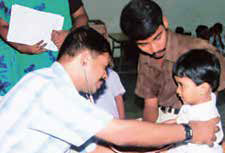
Post-Operative Endophthalmitis is the most dreaded nightmare of any eye surgeon. After diligent plannin and a meticulously done surgery, the last thing we want is an intraocular infection to ruin the outcome. For the patient, the consequences are devastating. Unfortunately, despite all precautions, infections do occur in best of hands and best of set ups. It is a reality that cannot be done away with. However, we can minimize the occurrence of postoperative endophthalmitis by taking adequate pre-operative, operative & postoperative measurers. The aim of this review is to acquaint eye surgeons with simple yet effective measures that go a long way in reducing the incidence of post-operative endophthalmitis. This review draws heavily from the recommendations of a workshop conducted under the aegis of AIOS, involving 22 leading ophthalmologists from across the country, to evolve guidelines to minimize postoperative endophthalmitis.
Preoperative measures

The planning for a good surgical outcome, both in terms of vision and prevention of post-operative infection, starts at the time of OPD evaluation of the patient. Common conditions that increase the probability of postsurgical endophthalmitis need to be recognized and dealt with prior to elective surgery. Uncontrolled diabetes, and coexistent cardiovascular, renal and hepatic disorders reduce the efficacy of the immune system, and are known to increase the chances of postoperative infection. Likewise, uncontrolled HIV infection compromises the ability of the body to fight against infection. A thorough medical history should be obtained to ascertain the presence of any of the above mentioned conditions. If present, adequate control should be ensured, and clearance should be taken from the concerned specialist prior to scheduling the patient for surgery.
For diabetic patients especially, even after clearance from the endocrinologist, a random blood sugar should be obtained at the time of scheduling the surgery and on the day of sugery. If >200 mg/dL, surgery should be deferred till optimal blood sugar control is established.
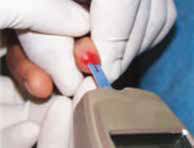
Localised ocular infections, like meibomitis and dacryocystitis, dramatically increase the likelihood of infectious organisms entering the eye during surgery. At the time of OPD evaluation, a regurgitation test needs to be performed. In the presence of a positive regurgitation test, or coexistent adnexal infections, surgery needs to be deferred and the relevant condition addressed.
Preoperative topical antibiotics have been shown to reduce the incidence of post-operative endophthalmitis. The ideal antibiotic should be bactericidal, have a broad spectrum of activity, and have low ocular toxicity. Flouroquinolones fit this bill perfectly, and are the preferred agents for preoperative prophylaxis. They have the added advantage of quick onset of action, so that they need to be started hours, and not days, before the scheduled surgery. The typical preoperative regimen involves gatifloxacin or moxifloxacin eye drops 3-4 times aday, started 1 day prior to scheduled surgery.
All the above measures, and some more, need to be adhered to for mass surgeries, such as in eye camps. In such settings, patients at higher risk of postoperative infections, like those discussed above, should not be operated. This is because the possibility of OT and surgical instruments’ sterility being compromised are higher in such settings. Combined surgeries, such as trabeculectomy + cataract surgery, should be avoided. High risk surgeries, that may require longer time than usual, should be done only by experienced surgeons, taking all due precautions.
Operative measures
Proper operation theatre (OT) etiquettes are to be followed by the entire staff, especially the operating surgeon. It is important that the staff be aware of these etiquettes. Important Do’s and Don’ts need to be written in legible writing or printed on posters and hung on the wall of the OT area for all to see.
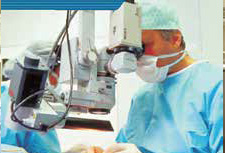
Any person (doctor/staff member/ patient) with upper respiratory tract infection, skin infection or any other obvious infection should refrain from entering the OT. No person is to enter the OT without wearing proper OT clothes. Street clothes are not to be allowed inside the OT. Likewise, wearing OT clothes over street clothes is not permissible. Using shoe covers is not enough. Shoes need to be removed, and dedicated OT slippers (made of rubber and washable) worn before entering the OT. OT cap and mask need to be used, taking care that the scalp hair have been properly tucked in beneath the cap, and the mask covers the nose properly.
For doctors, it is important to ensure that contact procedures like biometry or tonometry, are not performed on the patient’s eye on the day of surgery. Proper patient preparation is as crucial to surgical outcome as surgical skill. On the day of surgery, the patient should have had a proper bath, including thorough washing of the face with soap and water. Surgery should be cancelled if there if abnormal eye congestion or discharge from the eyes. Patients are to wear clean, washed OT clothes along with cap and gown prior to entering the OT. As discussed above, use of street clothes is not permissible. Though obvious, it is important to reiterate that a written informed consent needs to be taken from every patient undergoing surgery, clearly mentioning the possible risks and complications, including postoperative endophthalmitis.
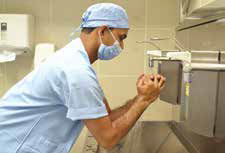
Hand washing is the single most important step in preventing postoperative infections. Proper hand washing for atleast 10 minutes using betadine/chlorhexidine solution under running tap water or boiledcooled water and taking care to reach all parts of the hand must be practiced by any person (surgeon, assistant, nurse) expected to be in direct contact with the operative field. After washing, hands should be dried using a sterile towel, taking care to rub from the tip of the fingers up to the elbow, in that sequence. Once the towel has moved up towards the elbow, it must not be brought down. A sterile OT gown should be worn, and sterilized gloves should be worn using proper technique. After putting on surgical gloves, the hands should always stay above the waist level and in front of the chest. Fresh surgical gloves need to be used for every case. If multiple surgeries are planned, rescrubbing, hand washing and wearing of fresh surgical gown needs to be done after every 5 patients. As a rule, more than 25 cases/8 hours of surgery per surgeon should not be planned for a single day.
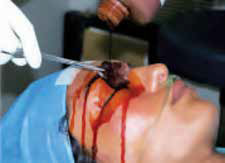
Try to make the patient as comfortable as possible during surgery. This will minimize the chances of patient fidgeting, moving his head or bringing his hand up to the operating. Not only will it make he surgery more convenient for the surgeon, it will reduce the likelihood of post-operative infections. If available in the setup, provide constant oxygen flow to the patient through nasal prongs or face mask to avoid the sensation of suffocation. Pulse oxymeter should be used, where available. Use microscope for any intraocular surgery. Magnifying glasses or surgical loupes do not provide the same level of magnification, and must not be used in intraocular surgeries.
In preparing the operative field, 5% povidone-iodine solution is to be applied on the skin around the eye, and left for atleast 3 minutes before being wiped. After this, the same solution needs to be poured into the conjunctival cul-de-sac, and left for at least a minute. A disposable adhesive drape is to be applied over the eye after wiping the povidone-iodine, taking care to tuck the eyelashes under the drape. A sterile speculum is to be used to keep the eyes open throughout surgery
During surgery, wherever possible, avoid uniplanar corneal incisions. A bi-triplanar corneal incision or scleral tunnel, as used for small incision cataract surgery, is self-sealing and always preferable to a clear corneal incision. This is more so for mass surgeries, as in eye camps. Whenever there is a doubt about wound integrity at the end of surgery, do not hesitate to apply sutures. A subconjunctival antibiotic-steroid combination should be injected at the end of surgery. If not possible due to fear of the patient squeezing his/her eye, a similar combination needs to be instilled into the eye prior to patching.
Phaco-tips and sleeves should be changed, and the tubings primed after every case. For any irrigating fluids that have been used, note the batch number of the bottle. Preferably keep the bottle in a safe place for atleast 24 hours after surgery, so that it can be sent for microbiological work up in the inadvertent event of a postoperative infection. Try to use a fresh bottle of irrigating fluid for every patient. Before using, inspect the bottle under light to look for any visible impurities. Document and discard the bottle if such is the case. Ringer lactate and Balanced salt solution are equally effective for intraocular surgeries, but balanced salt solution resembles the aqueous humor more closely physiologically, and is to be preferred where available. Use of antibiotic in irrigating fluid is not required, and has not been shown to alter the incidence of postoperative infections.
Post-operative measures
Good postoperative care ensures a smooth and speedy recovery for the patient. Conversely, a little carelessness on the part of the patient, or mismanagement on the part of the doctor, can ruin a perfectly good surgical outcome. It is important for both doctor and patient to be aware of the following simple yet effective measures that go a long way in reducing the incidence of postoperative endophthalmitis.
The eye should preferably be patched for atleast 6 hours after any intraocular surgery. Patching reduces the exposure of the eyes to environmental microbes in the immediate postoperative period. It also ensures that the patient does not rub his eyes unnecessarily. Rubbing of eyes after surgery needs to be avoided at all costs. If absolutely necessary, due to severe itching or watering from the eyes, it should be done with a clean cotton pad after washing hands with soap and water. The patient should use protective eye glasses/ shades for a week after surgery, especially when venturing outdoors. The need to maintain a good personal hygiene needs to be emphasized upon the patient.
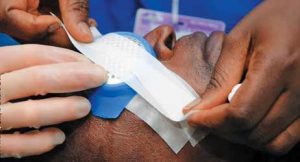
Topical antibiotics and steroids should continue for at least 4 weeks after surgery. Oral antibiotics are needed only for high risk cases. The patient should be examined on day 1, 3 and 7 following any intraocular procedure, if not earlier. On each visit, the visual acuity best corrected/pinhole) needs to be checked. A slit lamp examination should be done to look for anterio chamber inflammatory reaction. Direct or indirect ophthalmoscopic examination needs to be performed to look for media opacities. The doctor needs to maintain a very high index of suspicion for postoperative endophthalmitis. In case the visual acuity or the degree of intraocular inflammation do not match that expected for that particular surgery, the patient needs to be followed up very closely. The operating surgeon needs to ensure that either him or someone from his team is available at the hospital for at least a week following the surgery.
What to do in case of infections?
Post-operative endophthalmitis is a dreaded complication, both for the patient and the surgeon. It can rapidly destroy the vision of the patient, and can lead to pthisis bulbi in a short span of time. For the doctor, it can lead to unnecessary medicolegal issues, and can become a huge PR disaster. However, if spotted early and handled carefully, such problems can be avoided.
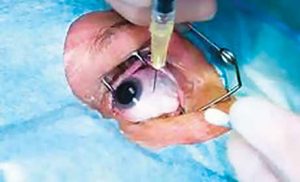
The first step is to convey the message to the patient and relatives. Be direct and forthcoming when informing the patient. The patient needs to know the seriousness of the situation, and need for prompt action. The mechanics of infection should be explained to the patient and relatives. They should be clearly told if the condition can be managed by you. If not, a prompt referral to a retina specialist should be done.
If managing yourself, get vitreous tap and send for Gram’s staining and bacterial and fungal culture and sensitivity. Give broad spectrum intravitreal antibiotics. The most preferred antibiotics for intravitreal use are a combination of vancomycin and ceftazidime. The patient should be followed very closely. All examination findings should be duly recorded on each visit. Do not hesitate to repeat intravitreal antibiotics if required. If the patient is not responding to intravitreal therapy, consider a pars plana vitrectomy for removal of the infectious load.
The entire OT sterilization process and part preparation process for surgery should be reviewed. Have discussions with the entire OT and CSSD staff to figure out any loopholes anywhere. Seal the whole OT complex. Take cultures from OT walls, floor and operating table, and send for culture and sensitivity. Note the batch numbers of all solutions used for that particular surgery, and send samples of these solutions for culture and sensitivity. Thereafter, these solutions should be sealed and kept in safe custody.
For cluster endophthalmitis, defined as the occurrence of two or more cases at the same time (from the same OT), the issue needs to be dealt with even more carefully. Here, the possibility of media exposure and public outcry is very real. Get the hospital authorities into the loop. Inform the CMO, Medical Superintendent and other senior authorities in the hospital. Most major hospitals have an infection control committee. Get the committee members involved. Take the help of the AIOS. If the situation seems to be getting out of control, get a lawyer. It may come in handy in case the issue goes to court. Regarding dealing with the press, let the hospital media/public relations committee deal with it.
Checklist for Elective Intraocular Surgery
- Random Blood Sugar <= 200 mg %
- BP < 150/90 mm Hg
- Physician Clearance in cases with Systemic Disease
- Pre-Op Topical Antibiotics
- Written Informed Consent in Patient’s Language
- No Contact Procedures / Syringing on day of Surgery
- Microscope Must
- Sterilized Gloves for every Case
- Disposal Adhesive Drape to isolate Lashes
- Betadine on Skin & Periorbital Area for 3 minutes
- Betadine in Conjunctival Sac for 1 minute
- Note Batch Number of Irrigating Fluids
- Document all findings (Pre-Op, Operative, Post-Operative)
- Instruments Autoclaved / ETO
- ‘NO’ chemical sterilization
- Maximise Use of Disposables
- In case of doubt of Infection :
- Talk to Patient/ Relatives
- Institute Prompt Appropriate Treatment
- Seek Help from higher Authorities